Very few things arouse me like a tantale and rose golden Royal Oak. Thus, sporting an AP 56175TR is an absolute dream come true. The Royal Oak was launched as a luxury steel sports watch, a genre that didn't really exist before 1972. Thus, from Day 1 the case material was a focus of the overall design and a guiding principle. Fast forward to 1988 and the tantale and rose (TR) combination oozes the same vibe of industrial metallurgy so embossed in the history of the Royal Oak while amplifying the visual and haptic experience through warm red golden hues. Imagine an architectural masterpiece in the setting sun. It is to me the perfect synergy of two phenomenal watch materials and the next level in the evolution of a pop-cultural icon.
April 10, 2024
Materialistic World - Why Tantalum is The Perfect Royal Oak Material
 Marcus Siems @siemswatches
Marcus Siems @siemswatches
Collector, Author, Data Analyst
I do not wanna sound obscene but ... very few things arouse me like a tantale and rose golden AP Royal Oak. Thus, sporting an AP 56175TR writing these lines is an absolute dream come true. The tantale and rose (TR) combination oozes the vibe of industrial metallurgy so embossed in the history of the Royal Oak while amplifying the visual and haptic experience through the warm red golden hues. Imagine a brutalist architectural masterpiece immersed in the soft light of a new dawn... It is to me the perfect synergy of two phenomenal watch materials.
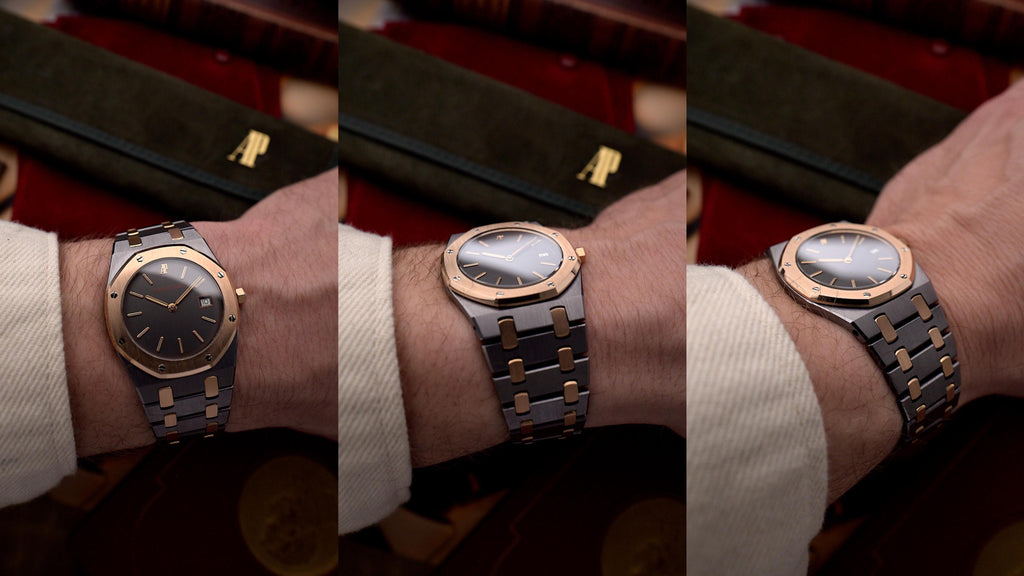 A pleasure on the wrist... As Tantalum is very heavy - indistinguishable from 18k gold actually - even the slim iterations have a wonderful presence on the wrist both haptically and visually.
A pleasure on the wrist... As Tantalum is very heavy - indistinguishable from 18k gold actually - even the slim iterations have a wonderful presence on the wrist both haptically and visually.
The Royal Oak originally is a steel watch. However, the Tantalum variations are the perfect extension to the classic principle... and here's why: The 5402 was launched as a luxury steel sports watch. That's a genre that didn't really exist before 1972. Thus, from Day 1 the Royal Oak put the focus on the case material and made it an integral part of the overall design and a guiding principle.
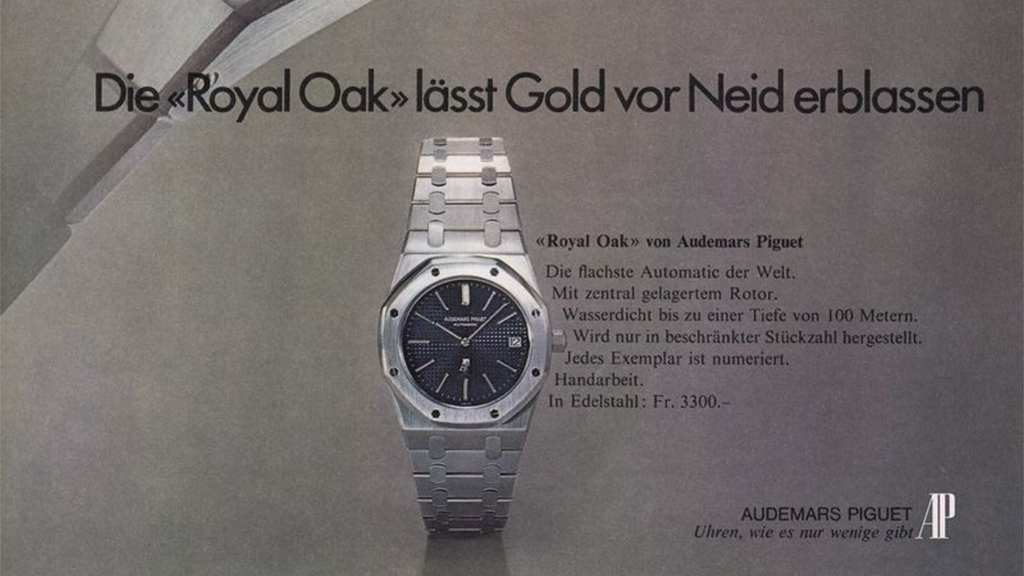 1972 Audemars Piguet Royal Oak Advertorial: "The Royal Oak makes gold green with envy". Ad Courtesy of HIFI Archiv.
1972 Audemars Piguet Royal Oak Advertorial: "The Royal Oak makes gold green with envy". Ad Courtesy of HIFI Archiv.
1) Tantalum
So how does tantalum fit into the equation? Tantalum is the 73rd element of the periodic table - a transition metal - that was discovered in the early 19th Century. It is a lot more greyish-blue than stainless steel and all in all a superhero material: extremely ductile, it also has a melting point over 3000 degree Celsius. It is further quite rare composing only about 0.0001-0.0002% of the earth's crust - less than 1,500t are sloped each year (In comparison it's over 2,500t annually for gold). It is also quite heavy: In comparison a Tantalum/rose gold ref. 56715 weighs in about as much as a compatible ref. 4100 in full 18k yellow gold (excluding movement), and about 50g more than a steel/gold bicolored example... Hefty!
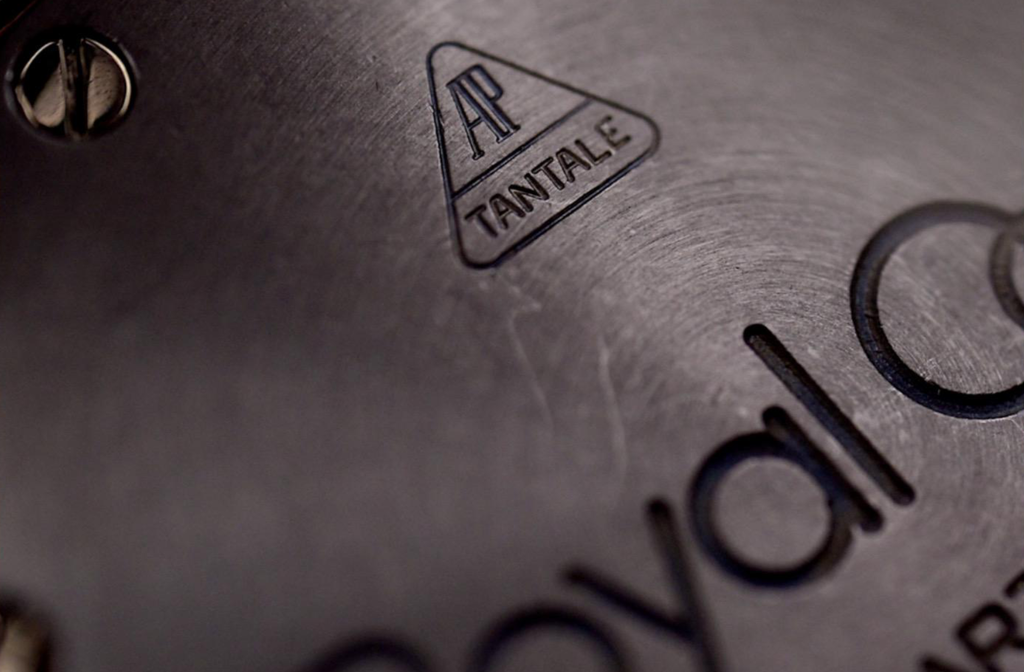 The case-back on the Royal Oak ref. 56175 reads "AP Tantale". You can see the beautiful grey-blue luster that's a lot deeper and darker than stainless steel.
The case-back on the Royal Oak ref. 56175 reads "AP Tantale". You can see the beautiful grey-blue luster that's a lot deeper and darker than stainless steel.
Tantalum has nowadays so many different applications because it doesn't scratch, is corrosion-resistant, doesn't react to bodily fluids and is basically hypoallergenic[4]. In comparison to other watch-affine materials Tantalum is next level: It is as hard as the best steel alloys (~200 Vickers; 18k gold is ~135 Vickers) and on top, boosts about double the tensile strength of steel and gold (900MPa vs. 515MPa and 500MPa, respectively). And these parameters are in its elemental form. It is therefore a technology-critical element used in electronic equipment and for medical purposes like implants. Yet, what you might have figured out yourself, it is outstandingly hard to work with. It cannot be soldered, which means you can only use it in one-element designs. Further, its characteristics make it close to impossible to grind - or in watch terms: finish.
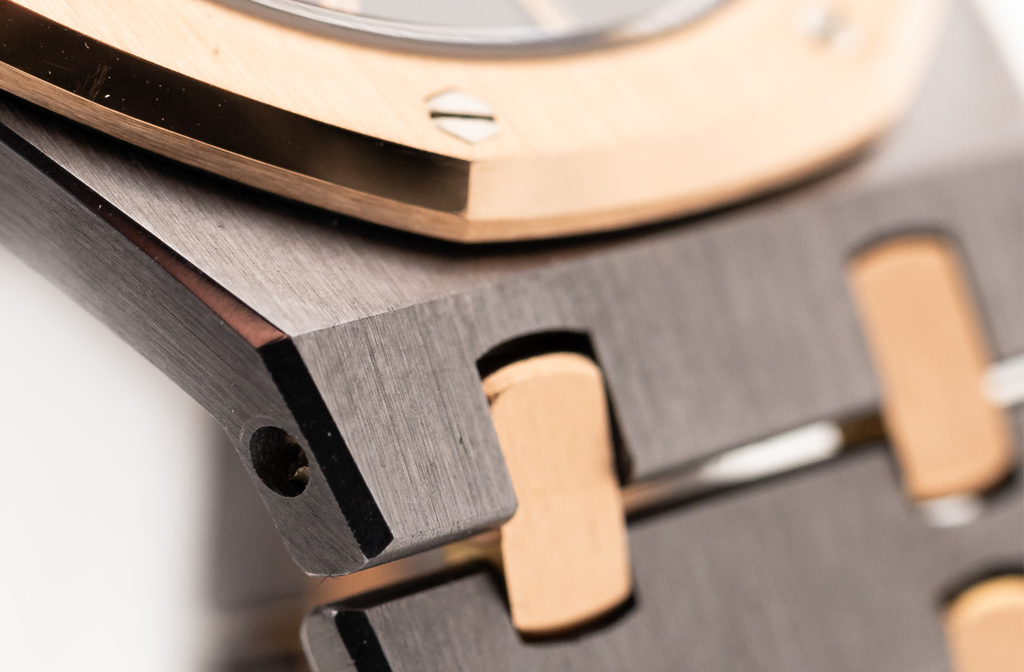 Zooming in on the finishing of a Tantalum Royal Oak ref. 56175. Photo from Goldammer Archives.
Zooming in on the finishing of a Tantalum Royal Oak ref. 56175. Photo from Goldammer Archives.
It's hard to work on this material, huh? Does that ring a bell? The original Royal Oak 5402 prototypes were made in white gold and not steel, as the steel alloy used for the 5402 was so difficult to work with. It's this extra mile that AP is going with the applied materials that are at the core of the Royal Oak lineups. And switching from steel to Tantalum is like going from gold to platinum - it's upping the ante even further!
2) The Beginning of Audemars Piguet's Tantalum Dreams
Audemars Piguet started to use their next-level material as early as 1986. As lore goes it was due to a request from King Juan Carlos of Spain that AP started to use Tantalum[1]. The Spanish King wanted his Royal Oak in a more blued hue - his signature style - but standard bluing techniques didn't quite do the job.
However, Tantalum made its debut in a serially produced watch not only as part of the Royal Oak collection. It was further launched as part of the Huitieme collection (reference 25644TR[2]) the first ultra-slim chronograph from Le Brassus around the same time in 1988.
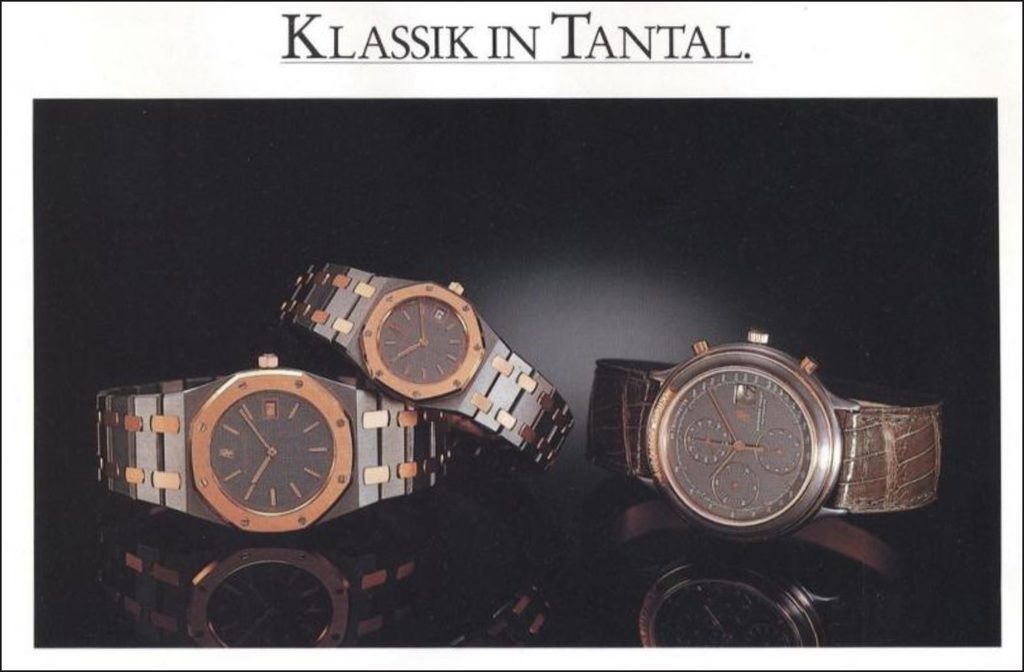 "Classic in Tantalum" - A late 1980s Audemars Piguet advertorial featuring the initial Tantalum Royal Oaks refs. 66270 and 56715 as well as the ref. 25644 Huitieme chronograph. Photo Courtesy of Grail Watch.
"Classic in Tantalum" - A late 1980s Audemars Piguet advertorial featuring the initial Tantalum Royal Oaks refs. 66270 and 56715 as well as the ref. 25644 Huitieme chronograph. Photo Courtesy of Grail Watch.
3) From Dream to Reality - Making Tantalum Watches
By now - over 35 years later - there exist a total of 8 different material codes and thus combinations: Full Tantalum (TL), Tantalum with steel (TS & TT), and rubber (TK) as well as the precious mixtures with pink gold (TR & OL), yellow gold (TA), and platinum (TP).
As I mentioned before it wasn't easy to make Tantalum work as a watch case due to its endurable characteristics. In the late 1980s Favre & Perret, the La Chaux-de-Fonds case maker for the Royal Oak, however made this dream become reality. Or as Wei Koh (Revolution Watches) & Erik Gustafson (Hairspring Watches and Former Physics Engineer) put it:
- "Crafting a case out of this incredibly dense material chewed up CNC machinery like crazy" - Wei Koh -
- "[Tantalum] is extremely finicky to machine and finish for watchmakers, it 'gums up' most machines" - Erik Gustafson -
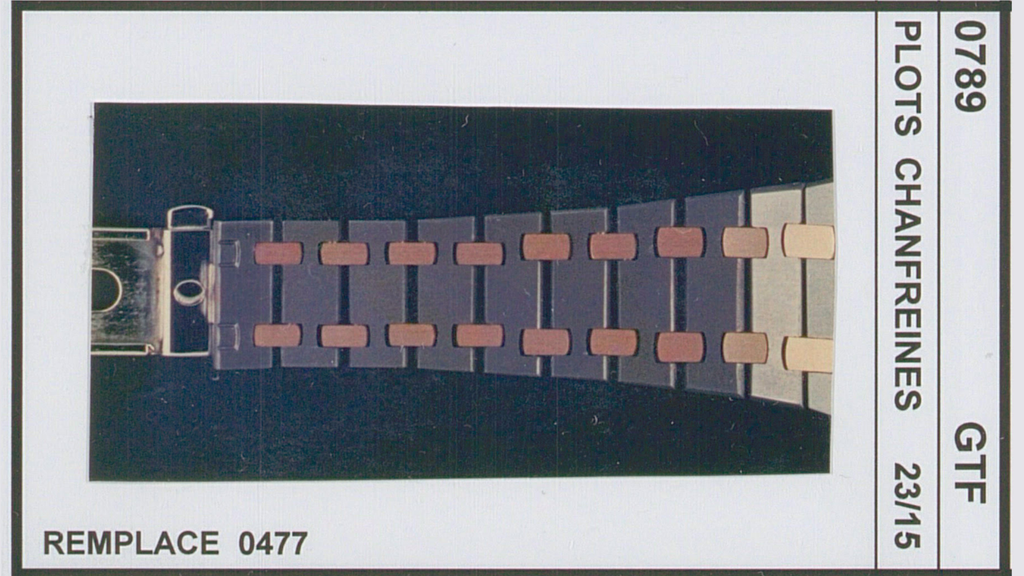 AP Chronicles insights into bracelet made by GTF (formerly Lascor, but not(!) Gay Freres) - also The manufacturer of the Tantalum bracelets. Photo Courtesy of AP Chronicles.
AP Chronicles insights into bracelet made by GTF (formerly Lascor, but not(!) Gay Freres) - also The manufacturer of the Tantalum bracelets. Photo Courtesy of AP Chronicles.
The bracelets were made by another supplier - namely GTF. GTF (formerly Lascor, pre-1986) was the manufacturer responsible for most of the Royal Oak bracelets and taking over the reigns from Gay Freres[2]... and this is an aspect worth noting: Gay Freres stamped their bracelets "GF" often featuring the "ram's head" stamp, too. GTF used a monogram stamp, which easily can appear like "GF" (see below). Well, it's a confusion even evident in some auction house catalogues - it's an honest mistake. But a mistake nonetheless: To the best of our knowledge Gay Freres didn't produce a single Tantalum bracelet.
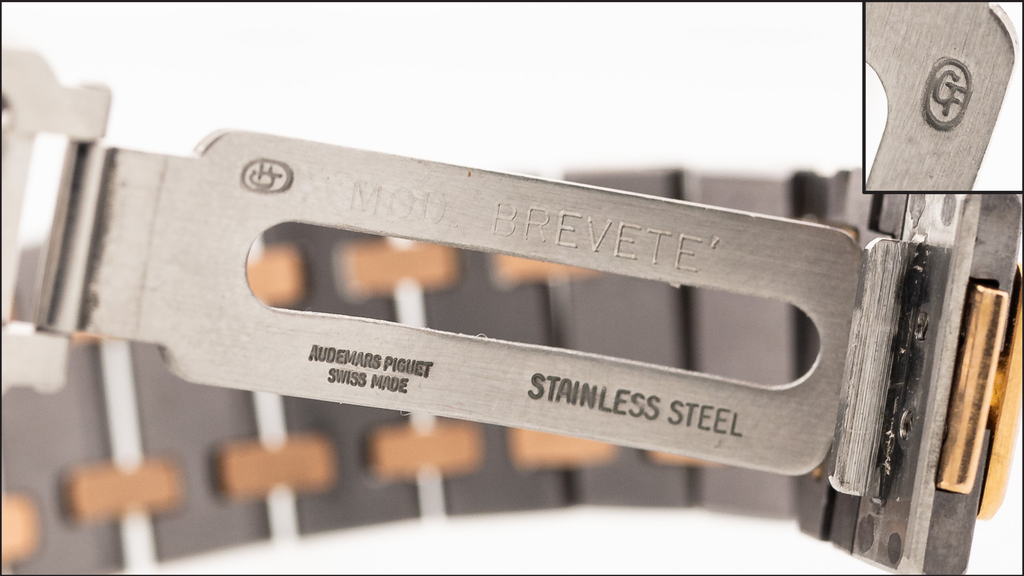 The clasp reads "GTF" (formerly manufacture Lascor) and not "GF" - it is not made by Gay Freres! Photo from Goldammer Archives.
The clasp reads "GTF" (formerly manufacture Lascor) and not "GF" - it is not made by Gay Freres! Photo from Goldammer Archives.
4) The Tantalum Royal Oak Production
With a clear focus on time-only Royal Oak models we can identify at least 9 distinct references launched between 1988 and 1997. Three of those came in two Tantalum combinations: with rose gold (TR) and steel with Tantalum (TT). However, be aware that chronographs, perpetual calendar and Offshore models did come in Tantalum as well.
 Figure 1. Overview over 8 out of 9 Royal Oak Tantalum time-only models. The upper left panel displays the dial variation introduced for the Tantalum references - the Dacron vertically brushed dial. Photos Courtesy of Antiquorum , Sotheby's, Phillips, Watches of Knightsbridge, & AP Chronicles.
Figure 1. Overview over 8 out of 9 Royal Oak Tantalum time-only models. The upper left panel displays the dial variation introduced for the Tantalum references - the Dacron vertically brushed dial. Photos Courtesy of Antiquorum , Sotheby's, Phillips, Watches of Knightsbridge, & AP Chronicles.
| Ref. | Years | Production | Size | Movement |
|---|---|---|---|---|
| 56175 TR | 1988-90s | ??? | 33mm |
cal. 2612 (Quartz) |
| 56175 TT | 1990s | 2,000 | 33mm | cal. 2612 |
| 66270 TR | 1988-90s | ??? | 24mm | cal. 2610 (Quartz) |
| 14486 TR | 1988-2004 | 215 | 35mm | cal. 2130 (Automatic) |
| 14790 TR | 1992-2005 | ??? | 36mm | cal. 2225 (Automatic) |
| 14790 TT | 1992-2005 | ??? | 36mm | cal. 2225 |
| 14800 TR | 1992-2005 | ??? | 36mm | cal. 2225 |
| 14470 TR | 1993-99 | 114 | 30mm | cal. 2130/31/50 |
| 14882 TT | 1994 | 50 | 33mm | cal. 2003SQ (Manual) |
| 14587 TR | 1995 | 1 | 30mm | cal. 2130 |
| 15000 TT | 1996-2003 | 149 | 33mm | cal. 2140 (Automatic) |
| 15000 TR | 1997-2003 | 73 | 33mm | cal. 2140 |
Table 1. Overview over 8 Audemars Piguet Royal Oak references featuring Tantalum cases in 11 different executions.
Overall, we can find 9 references in 12 distinct metal executions (TR & TT) featuring Tantalum. Interestingly, the first Tantalum ROs were Quartz powered (56175 & 66270) and only a couple of months later reinforced by the automatic reference 14486 (cal. 2130). After the initial introduction Tantalum Royal Oaks came with (automatic) mechanical movements - the sole manually wound example being the ref. 14882 with the cal. 2003[2]. By the way, none of the references comes in a Jumbo case (39mm). And the ref. 14800 can be called an oddball among the rest as it is the only one that comes on a strap instead of a bracelet (it's otherwise identical to the ref. 14790).
 Figure 2. Production numbers of mechanical Audemars Piguet Royal Oak references with Tantalum cases by reference (left) and year (right). The colors (left panel) display the combination material - orange and grey for rose gold and steel, respectively. Data Courtesy of AP Chronicles.
Figure 2. Production numbers of mechanical Audemars Piguet Royal Oak references with Tantalum cases by reference (left) and year (right). The colors (left panel) display the combination material - orange and grey for rose gold and steel, respectively. Data Courtesy of AP Chronicles.
Well, since Tantalum has been "chewing through CNC machinery like crazy" production output has been very limited. The AP chronicles are typically quite complete but unfortunately the full production outcome is not known (as of now). However, we can see that over the mechanical references (excluding refs. 14790/14800) the total production was at a mere 602[2]. Little is known about the Quartz-powered references but the steel/Tantalum ref. 56175 - the Nick Faldo "Championship" - was made in a limited edition of 2,000 pieces[3].
5) Concluding Remarks
In the end, I'm still sitting here, admiring my 56175TR and thinking: Why isn't Tantalum more of a thing? I guess it's partially due to a lack of knowledge. Not many people outside the watch collecting community will know that a Tantalum Royal Oak does exist (let alone more than one)***.
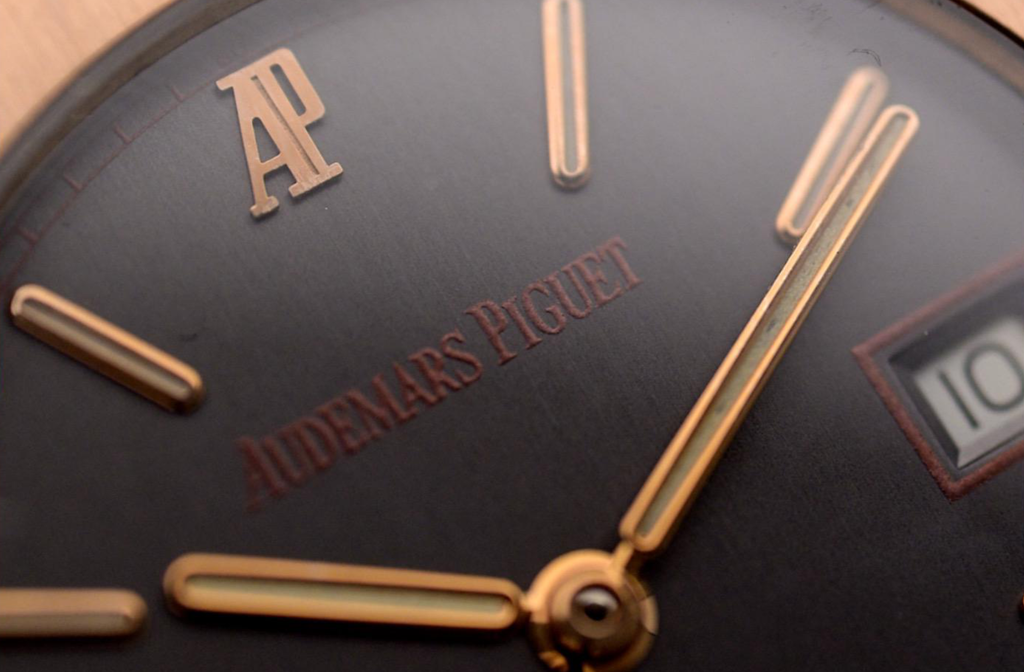 A wonderful detail only found on Tantalum pieces from Audemars Piguet - the Dacron vertically brushed dial in slate grey with rose golden accents.
A wonderful detail only found on Tantalum pieces from Audemars Piguet - the Dacron vertically brushed dial in slate grey with rose golden accents.
But there are several characteristics unique to many Tantalum examples that are simply un-Royal Oak. The first obvious one is the Tantalum itself, which might put off some Royal Oak hardliner. Second is the fact that these never came in 39mm. The Jumbo case is The classic Royal Oak size but you will find the Tantalum references only at 36mm or below. Third, is about the dial. One of the major contributions of the early RO references has been the introduction of the intricate "tapiserrie" dial (T21) made by Stern Freres. It is great that AP introduced their own non-tapisserie dial variants for the Tantalum models yet from a modern perspective this might be off putting to some of the collector community*.
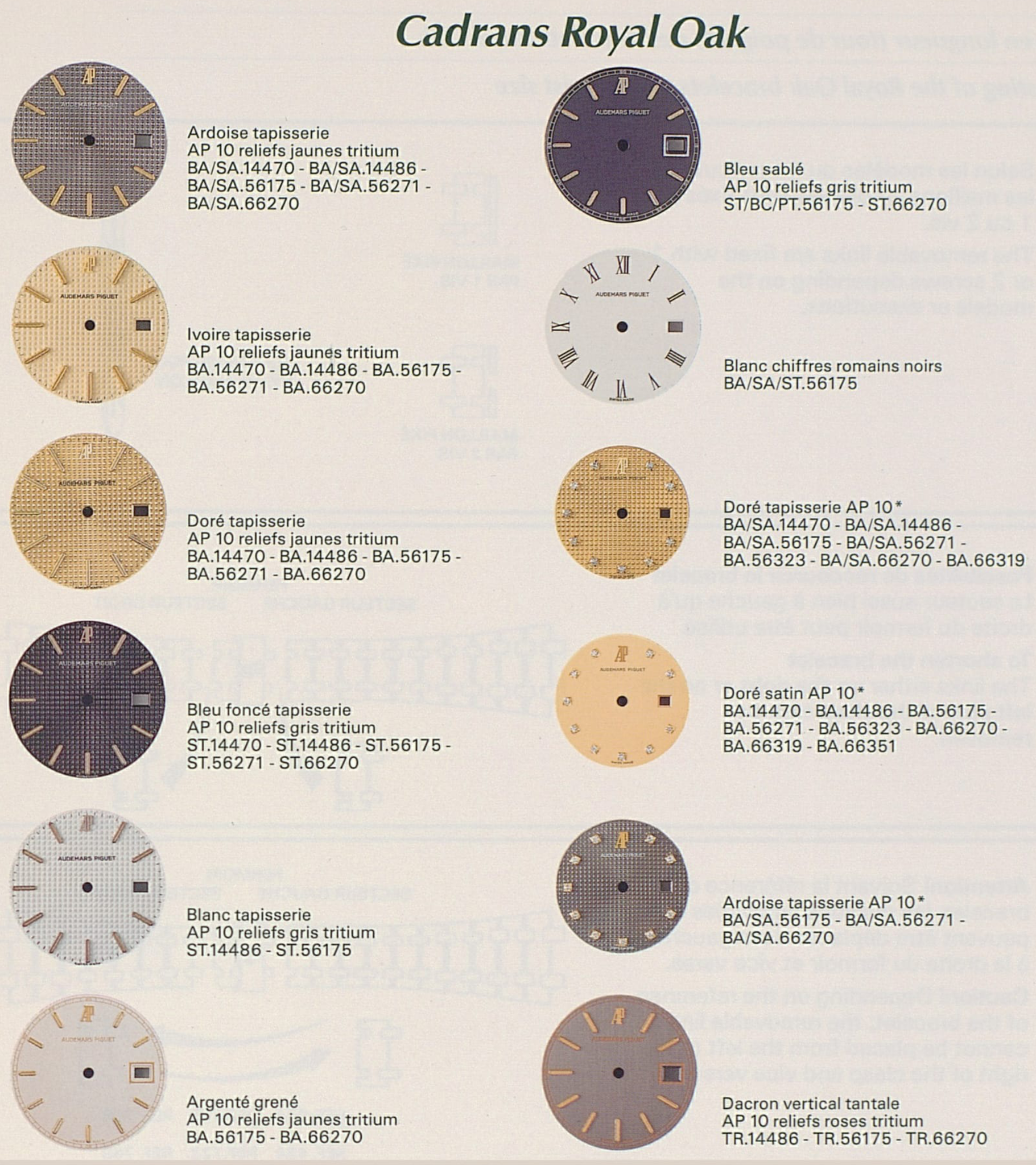 Different dial variations for the initial Royal Oak references 56175, 14486, & 66270 featuring Tantalum cases. Yet, only the "Dacron vertical tantale" (lower right) can be found inside the greyish-blue metal encasings. Photo Courtesy of AP Chronicles.
Different dial variations for the initial Royal Oak references 56175, 14486, & 66270 featuring Tantalum cases. Yet, only the "Dacron vertical tantale" (lower right) can be found inside the greyish-blue metal encasings. Photo Courtesy of AP Chronicles.
Fourth, as got clear from the Revolution Watch quote the cases were made with CNC**. Moreover, due to the extreme hardness of the material hand-finishing becomes virtually obsolete and the amount of fine craftwork is limited. And Fifth, as Erik Gustafson puts it:
- "[the way Tantalum is used] has always been a head-scratcher for me because surely that should be the material for the bezel, where scratches are usually directed" - Erik Gustafson (Hairspring Watches) -
And he's got a point. Potentially making the hexagonal holes for the bezel screws is simply not feasible with Tantalum. That's a compromise that would kinda negate the entire idea of using Tantalum in the first place.
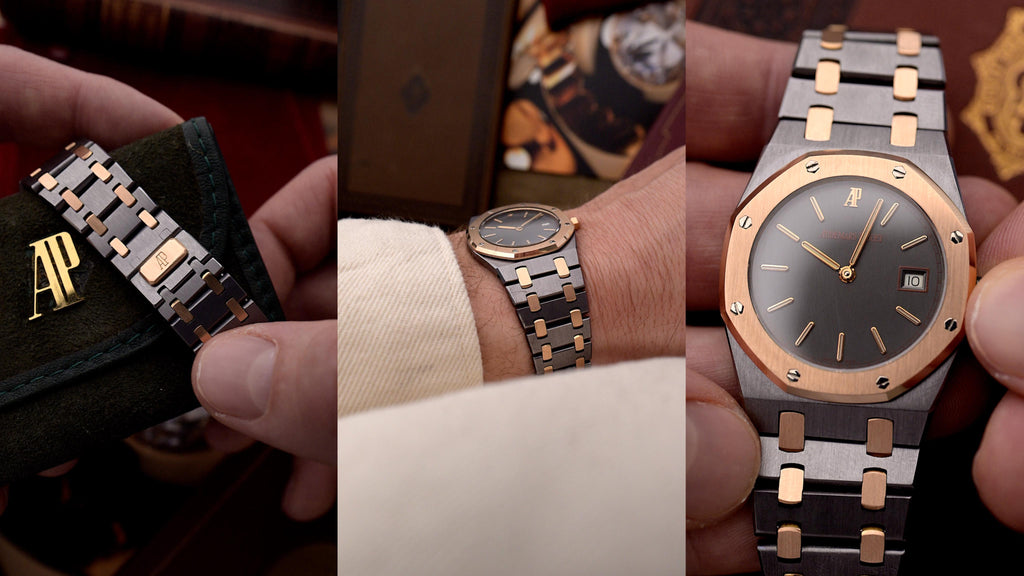 No words needed, just that mesmerizing Tantalum luster!
No words needed, just that mesmerizing Tantalum luster!
The Tantalum Royal Oak is definitely something for the connoisseur, it's an acquired taste of sorts. Only when you think a vintage Royal Oak is just too pedestrian, you might look out for a Tantalum example. And even then it takes quite some digging to find one. The good thing is - it's basically scratch resistant - so many of the pieces still floating around will be in quite pristine condition.
But all numbers and facts aside... this is just my Royal Oak. It's the classic with an edge. It's the basic principle and improving it on a meta-level. It is everything that the ref. 5402 stands for yet at the same time they are some of the most atypical models you can imagine.
For me the Royal Oak stands for ingenuity and reinterpreting our idea of how watch cases have to be formed, shaped and feel like. In that sense Tantalum is in the same spirit and as revolutionary as the original steel reference 5402 from 1972!
I'd like to thank Erik Gustafson (Hairspring Watches) for his opinions on the Tantalum Royal Oaks that he was kind enough to share with me.
* Even though later Tantalum references did feature Tapisserie dials as well but it might have been too late... and it also doesn't really do it for me either.
** As is basically true for all Royal Oak references... However, you could still hand-finish steel and gold.
*** By the way, for example F.P. Journe are also making modern Tantalum watches (Chronometre Bleu), as are Omega, Panerai, Hublot and Jaeger-LeCoultre.
References
[1] Material World: Audemars Piguet's Pioneering Approaches to Material Innovation; Wei Koh, Revolution Watches [Link]
[2] AP Chronicles - Explorer; Audemars Piguet [Link]
[3] In-Depth: The Tale of Single-Tone, Two-Metal Audemars Piguet Royal Oak; Cara Barrett, Hodinkee [Link]
[4] Rare Cases: The Tale of Tantalum; Jason Swire, Hailwood Peters Watches [Link]
All rights on text and graphics reserved to the Author.





















0 comments